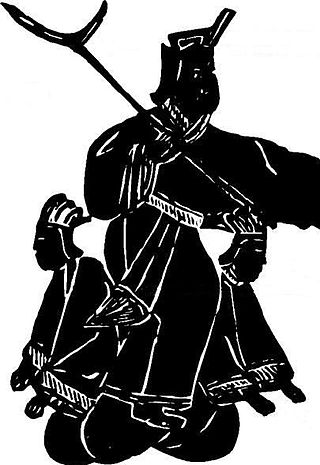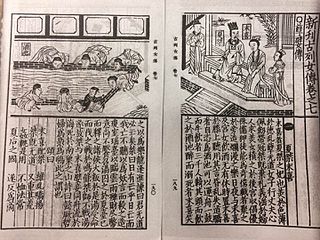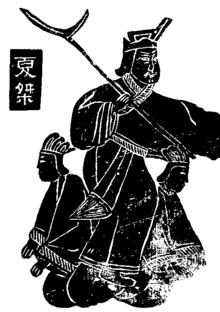
The Shang dynasty, also known as the Yin dynasty, was a Chinese royal dynasty that ruled in the Yellow River valley during the second millennium BC, traditionally succeeding the Xia dynasty and followed by the Western Zhou dynasty. The classic account of the Shang comes from texts such as the Book of Documents, Bamboo Annals and Shiji. Modern scholarship dates the dynasty between the 16th and 11th centuries BC, with more agreement surrounding the end date than beginning date.

The Xia dynasty is the first dynasty in traditional Chinese historiography. According to tradition, it was established by the legendary figure Yu the Great, after Shun, the last of the Five Emperors, gave the throne to him. In traditional historiography, the Xia was succeeded by the Shang dynasty.

Jin, originally known as Tang (唐), was a major state during the middle part of the Zhou dynasty, based near the centre of what was then China, on the lands attributed to the legendary Xia dynasty: the southern part of modern Shanxi. Although it grew in power during the Spring and Autumn period, its aristocratic structure saw it break apart when the duke lost power to his nobles. In 403 BC, the Zhou court recognized Jin's three successor states: Han, Zhao, and Wei. The Partition of Jin marks the end of the Spring and Autumn period and the beginning of the Warring States period.
Sima is a Chinese family name. It is one of the rare two-character Chinese family names; most Chinese family names consist of only a single character. It is an occupational surname, literally meaning "control" (sī) "horses" (mǎ), or "horse officer". The family name originated from one of the offices of the Zhou dynasty.

Yinxu is a Chinese archeological site corresponding to Yin, the final capital of the Shang dynasty. Located in present-day Anyang, Henan, Yin served as the capital during the Late Shang period which spanned the reigns of 12 Shang kings and saw the emergence of oracle bone script, the earliest known Chinese writing. Along with oracle bone script and other material evidence for the Shang's existence, the site was forgotten for millennia. Its rediscovery in 1899 resulted from an investigation into oracle bones that were discovered being sold nearby. The rediscovery of Yinxu marked the beginning of decades of intensive excavation and study. It is one of China's oldest and largest archeological sites, and was selected by UNESCO as a World Heritage Site in 2006. Yinxu is located in northern Henan, near modern Anyang and the borders Henan shares with Hebei and Shanxi. Public access to the site is permitted.

King Jie was the 17th and last ruler of the Xia dynasty of China. He is traditionally regarded as a tyrant and oppressor who brought about the collapse of a dynasty.
For most of its history, China was organized into various dynastic states under the rule of hereditary monarchs. Beginning with the establishment of dynastic rule by Yu the Great c. 2070 BC, and ending with the abdication of the Xuantong Emperor in AD 1912, Chinese historiography came to organize itself around the succession of monarchical dynasties. Besides those established by the dominant Han ethnic group or its spiritual Huaxia predecessors, dynasties throughout Chinese history were also founded by non-Han peoples.

Xia, known in historiography as Hu Xia (胡夏), Northern Xia (北夏), Helian Xia (赫連夏) or the Great Xia (大夏), was a dynastic state of China ruled by the Helian clan of Xiongnu ethnicity during the Sixteen Kingdoms period. Prior to establishing the Xia, the imperial clan existed as a tribal entity known as the Tiefu.

King Zhou was the pejorative posthumous name given to Di Xin of Shang or Shou, King of Shang, the last king of the Shang dynasty of ancient China. He is also called Zhou Xin. In Chinese, his name Zhòu also refers to a horse crupper, the part of a saddle or harness that is most likely to be soiled by the horse. It is not to be confused with the name of the succeeding dynasty, which has a different character and pronunciation.

Cheng Tang, recorded on oracle bones as, in English, Tai Yi (太乙) or Da Yi (大乙), was the first king of the Shang dynasty. Tang is traditionally considered a virtuous ruler, as signified with the common nickname of "Tang the Perfect" given to him. According to legend, as the last leader of the Predynastic Shang he overthrew Jie, the last king of the Xia dynasty.

Qi was a Chinese king, the son of Yu the Great and the second sovereign of the Xia dynasty. He ruled for roughly nine to ten years.

Yi Yin, was a Chinese politician who served as a minister of the early Shang dynasty and one of the honoured officials of the era. He helped Tang of Shang, the founder of the Shang dynasty, to defeat King Jie of Xia. Oracle inscriptions of Yi have been found, providing his social status was high.
The Nine Tripod Cauldrons were, a collection of ding in ancient China that were viewed as symbols of the authority given to the ruler by the Mandate of Heaven. According to the legend, they were cast by Yu the Great of the Xia dynasty.

The Xunyu is the name of an ancient nomadic tribe which invaded China during legendary times. They are traditionally identified with the Guifang, the Xianyun and the Xiongnu.
Chunwei is a name associated with the Xiongnu, a tribal confederation of nomadic peoples who, according to ancient Chinese sources, inhabited the eastern Eurasian Steppe from the 3rd century BC to the late 1st century AD.

A gu is a type of ancient Chinese ritual bronze vessel from the Shang and Zhou dynasties. It was used to drink wine or to offer ritual libations.

Lì is the pinyin romanization of the Chinese surname written 酈 in traditional character and 郦 in simplified character. It is also spelled Lik according to the Cantonese pronunciation. It is listed 303rd in the Song dynasty classic Hundred Family Surnames.

Mo Xi (Chinese: 妺喜; pinyin: Mò Xǐ; Wade–Giles: Mo4Hsi3) was a concubine of Jie, the last ruler of the Chinese Xia dynasty. According to tradition, Mo Xi, Da Ji (concubine of the last ruler of the Shang dynasty) and Bao Si (concubine of the last ruler of the Western Zhou dynasty) are each blamed for the fall of these respective dynasties. According to the Spring and Autumn Annals of Wu and Yue, “Xia fell because of Mo Xi; Yin (Shang) fell because of Da Ji; Zhou fell because of Bao Si” (夏亡以妹喜,殷亡以妲己,周亡以褒姒). Neither Mo Xi nor the Lake of Alcohol, with which she is associated, is mentioned in the story of Jie and the fall of Xia dynasty in the Records of the Grand Historian.
The periodization of the Shang dynasty is the use of periodization to organize the history of the Shang dynasty in ancient China. The Shang dynasty was a Chinese royal dynasty that ruled in the Yellow River valley for over 500 years, traditionally succeeding the Xia dynasty and followed by the Zhou dynasty. According to the conventional narrative of later transmitted texts, the Shang clan, led by their great leader Tang, defeated Jie of the Xia dynasty and founded a new dynasty known as Shang. The Shang moved their capital several times during the existence of the dynasty, eventually settling in a place called Yin, later known in the transmitted texts as Yinxu, located on the outskirts of the modern city of Anyang. It was eventually conquered by the Predynastic Zhou led by King Wu following the Battle of Muye in ca. 1046 BC, which led to the establishment of the Western Zhou dynasty. Scholars divide the Shang dynasty into periods for convenience, usually relating to the location of the dynasty's capital.
Predynastic Shang or Proto-Shang refers to the state of Shang that is believed to have existed during the Xia dynasty in ancient China, before its conquest of the Xia in approximately 1600 BC that led to the establishment of the Shang dynasty. The Predynastic Shang started from Xie, a son of Emperor Ku and the first known Shang ancestor. Xie is said to have helped Yu the Great, the founder of the Xia dynasty, to control the Great Flood and for his service to have been granted a place called Shang as a fief. The period would last until Tang defeated Jie of Xia in the Battle of Mingtiao, eventually overthrowing the Xia dynasty.















